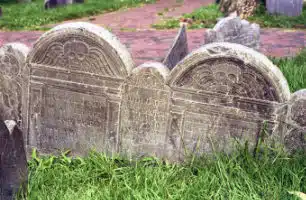In 1715, the first lighthouse in America is authorized for construction on Little Brewster Island, Massachusetts, and is known as the Boston Light.
The first lighthouse to be built in Boston Harbor dates back to 1716, and was the first lighthouse to be built in what is now the United States. The current lighthouse dates from 1783. It is the second oldest working lighthouse in the United States (after Sandy Hook Lighthouse in New Jersey) and is the only lighthouse to still be actively staffed by the United States Coast Guard despite its automation in 1998. The structure was designated a National Historic Landmark in 1964.
The Tragic Death of George Worthylake and His Family

The first keeper of Boston Light was George Worthylake. He drowned, along with his wife and 15-year-old daughter, when returning to the island in 1718.
On November 3, 1718, Worthylake, his wife Ann, daughter Ruth, and three others, drowned while returning to the island after attending church in Boston. About one month later, an enterprising twelve-year old boy named Benjamin Franklin wrote a ballad called The Light House Tragedy. He sold a printed handbill of the song in the streets of Boston, which gave this event its nickname.
The 1718 Boston Newsletter describes the tragedy:
“On Monday last the 3d currant an awful and lamentable Providence fell out here. Mr. George Worthylake, (Master of the Light-House upon Great Brewster (called Beacon Island) at the entrance of the harbour of Boston), Anne his wife, Ruth their daughter, George Cutler, a servant, Shadwell their negro slave, and Mr. John Edge a passenger; being on the Lord’s Day here at sermon, and going home in a sloop, dropt anchor near the landing place, and all got into a little boat or cannoo, designing to go on to shoar, but by accident overwhelmed it, so that they were drowned, and all found, and interred except George Cutler.”
Ben Franklin’s song was lost in time, but Maurice Babcock believed he found it in 1940, but we can never know for sure. Franklin later wrote in his autobiography that the poem was “wretched stuff,” although it “sold prodigiously.” He was only about 12 at the time.
It was discovered in an abandoned house on a nearby island by Maurice Babcock, Jr., son of the principal keeper of Boston Light. Edward Rowe Snow, a popular historian of the New England coast who lived nearby in Winthrop, Massachusetts, helped him identify what he had found. In the video clip here recorded in 1988, he describes finding the poem.
The Lighthouse Tragedy
Oh! George. This wild November
We must not pass with you
For Ruth, our fragile daughter,
Its chilly gales will rue.
So, home to Lovell’s Island
Take us when fails the sea.
To the old house where comfort
And better shelter be.
Comes the long weary winter
With its storms of driving snow;
I can only watch the beacon.
Sure that you are near its glow.
Yes, dear wife, my constant service
Binds me to this narrow isle,
Love must ever yield to duty
Though the heart be sad the while.
Only grant that on the morrow
We may safely pass the sea,
I can bravely bear my sorrow
You and Ruth here will not be.
With wild nor’wester came this morning,
Cold and clear the heartless sky.
Come wife, take Ruth. The pull will be long.
So – into the boat I will row you home.
Nestled within her mother’s cloak
Frail Ruth is sheltered from the blast,
While Anne looks into George’s face
With quick, strong strokes they leave the shore.
Though starting in the Brewster’s lea,
Rough and empty rolls the sea.
Low the boat — too deeply laden
Heavy hearts make heavy burden.
Now they reach the open channel
Where the flood tide breasts the gale
Rears a toppling wall of water.
Making Anne’s cheeks grow pale.
Quick the prow is upward borne.
George in Ann’s arms is thrown.
Husband, wife and child together
To the chilly waves have gone.
Frenzied clasp of wife and daughter
Bears the sturdy swimmer down,
Save the boat upon the water.
Nothing of their fate is known.
The American Revolution
During the American Revolution, the original lighthouse was held by British forces and was attacked and burnt on two occasions by American forces. As the British forces withdrew in 1776, they blew up the tower and completely destroyed it.
The lighthouse was eventually reconstructed in 1783, to the same 75-foot (23 m) height as the original tower. In 1856 it was raised to its present height of 98 feet (30 m) and a new lantern room was added along with a 12-sided second order.
Report from 8 years ago:

